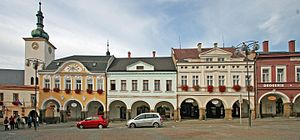Ústí nad Orlicí
| Ústí nad Orlicí | ||||
|---|---|---|---|---|
|
||||
| Basic data | ||||
| State : |
|
|||
| Region : | Pardubický kraj | |||
| District : | Ústí nad Orlicí | |||
| Area : | 3636 ha | |||
| Geographic location : | 49 ° 58 ′ N , 16 ° 24 ′ E | |||
| Height: | 340 m nm | |||
| Residents : | 14,196 (Jan 1, 2019) | |||
| Postal code : | 562 01 - 562 06 | |||
| structure | ||||
| Status: | city | |||
| Districts: | 8th | |||
| administration | ||||
| Mayor : | Petr Hájek (as of 2017) | |||
| Address: | Sychrova 16 562 24 Ústí nad Orlicí 1 |
|||
| Municipality number: | 579891 | |||
| Website : | www.ustinadorlici.cz | |||
Ústí nad Orlicí ( German wild sword ) is a town in the Pardubický kraj region . It is located in the Eagle Foothills at the confluence of the Silent Eagles and the Bohemian Drives . The historic city center was declared a monument protection zone in 1991.
history
Wildenschwert was founded in 1241 by Wilhelm von Dürnholz as Wilhelmswert and at that time belonged to the Landskron lordship . The Bohemian King Wenceslas II donated the place to the Cistercian monastery Königsaal in 1292 , for whose endowment it was used. Wildenschwert gave this to the diocese of Leitomischl in 1358 . After the fall of the diocese as a result of the Hussite Wars , the place passed into secular possession and belonged to the noble families Kostka von Postupice , von Pernstein and Hrzan von Harras . Wildenschwert was first referred to as a city in 1544.
Since the end of the 15th century there was a community of the Bohemian Brothers in Wildenschwert , who were expelled in the course of the Counter Reformation in 1626. After the Battle of the White Mountains , Wildenschwert was transferred to the Liechtenstein family . Although weavers' and cloth makers' guilds have been traceable since the 16th century , the city only recovered slowly from the looting during the Thirty Years' War . In 1706 a fire ravaged the city. In 1795 Wildenschwert was released from Liechtenstein rule and elevated to the status of a municipal town .
With the connection to the rail network of the Olomouc – Prague railway line in 1845, the city, which from the end of the 18th century also bore the Czech name Oustí or Austi , experienced an economic boom. The expanding textile factories gave the city the nickname "East Bohemian Manchester" and made it one of the most important centers of the textile industry . As a result of the increased economic importance, Wildenschwert became a district town in 1850.
Attractions
- town hall
- Church of the Assumption
- Dean's office building
- Way of the Cross
- Marian column
- Functionalist theater by the architect Kamil Roškot
- Christmas crib exhibition in the city museum
- Andrlův chlum lookout tower
sons and daughters of the town
- František Martin Pecháček (1763–1816), composer
- Quido Kocián (1874–1928), sculptor
- Fritz Löhner-Beda (1883–1942), songwriter and writer
- Jaroslav Kocian (1883–1950), violin virtuoso
- František Korte (1895–1962) composer
- František Uhlíř (* 1950), jazz musician
- Iveta Zelingerová-Fořtová (* 1972), cross-country skier
- Ondřej Valenta (* 1973), cross-country skier
- Rudolf Skácel (* 1979), football player
- Michal Šlesingr (* 1983), biathlete
- Ondřej Moravec (* 1984), biathlete
- Jaroslav Kulhavý (* 1985), cyclist
- Kamil Vacek (* 1987), football player
City structure
- Černovír ( Chernovians )
- Dolní Houžovec ( Seibersdorf )
- Horní Houžovec ( Hertersdorf )
- Hylváty ( Hil Betten )
- Kerhartice ( Gersdorf an der Adler )
- Knapovec ( Knappendorf )
- Oldřichovice ( Dreihöf )
- Ústí nad Orlicí ( Wild Sword )
Twin cities
- Amberg , Germany
- Bystrzyca Kłodzka , Poland
- Massa Martana , Italy
- Berlin-Neukölln , Germany
- Poprad , Slovakia
Population development
| year | 1970 | 1980 | 1991 | 2001 | 2003 |
|---|---|---|---|---|---|
| Residents | 12,843 | 15,288 | 15,295 | 15.192 | 15,031 |

literature
- Joachim Bahlcke , Winfried Eberhard, Miloslav Polívka (eds.): Handbook of historical places . Volume: Bohemia and Moravia (= Kröner's pocket edition . Volume 329). Kröner, Stuttgart 1998, ISBN 3-520-32901-8 , pp. 661-662.
Web links
- Homepage (cz / en / de)
- History (cz)
- Pictures and background information ( Memento from September 27, 2007 in the Internet Archive )







